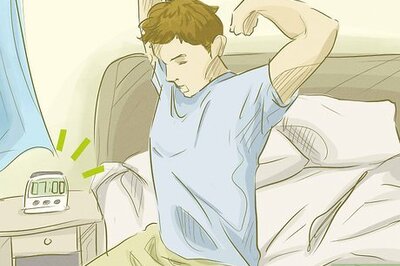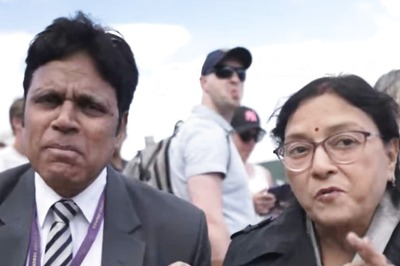
views
The Covid-19 lockdown has been extended further from April 15 to May 3. As per an Oxford University study, India’s lockdown has been the most stringent among all countries. People have begun wondering when things will get back to normal. Barring a handful of experts, few realise that it is thanks to such tough and timely decisions that India’s under-resourced health system has so far acquitted itself admirably in its handling of the Covid-19 pandemic relative to other countries having far better endowed health systems.
As on April 10, India had only had 6 positive cases and 0.2 deaths per million population, whereas comparable figures for the United States and Spain respectively were 1,520 and 57 and 3,385 and 344.
Having said that, the battle is far from over. The virus has proven to be highly contagious and till such time as a vaccine is available or the time when herd immunity is achieved – which is 12-18 months away – we have to adjust our lifestyles to the new normal of physical distancing, masks and lockdowns of varying degrees. The risk of spiralling of the contagion and a second wave of infection as we gradually reopen our economic activity is real and should not be underestimated.
It would be useful to remind ourselves of the lessons from mortality figures in the Spanish Flu pandemic that ravaged India in 1918. An estimated 1.5 crore people perished then, with relatively fewer deaths in March and April and then a subsequent deluge of deaths in the winter months.
Preventive public health measures such as lockdown, social distancing and other restrictive measures are no magic bullets. They cannot make the virus vanish; they only help in slowing down the spread of infection. Besides they cannot be continued indefinitely. They also impose severe economic and human costs.
The heart-rending stories of deaths of migrant workers and their children trudging thousands of kilometres from their places of employment to the safety of their home having been unwittingly caught in the lockdown is a manifestation of the severe economic costs that this move has imposed on our firms, financial system and even more so on the largely informal labour force, who are very weakly protected by the social safety nets.
Even by most conservative estimates, we are losing Rs 50,000 crore of value in national output every single day that our economy remains in the shutdown mode. The spectre of revenue-starved firms cutting down on investments and operations, consequent rise in unemployment, large scale loan defaults with potential risk for financial system stability is by no means illusory.
Realising the seriousness of the situation, both the government and the Reserve Bank of India have swung into action and we have seen a slew of measures to ensure that things don’t go out of hand.
Is then there a golden mean as the way ahead between the indiscriminate physical distancing policy dictated by the health imperative and the unfettered freedom for wealth creation flowing from the economic imperative? Fortunately, the answer is a qualified 'yes'. Before I come to the specifics of the solution, it is important to understand the underlying reason as to how the lockdown works.
Assume that 1% of the population is currently infected. Okay, I am making up this number because we don’t have a real measure of that. If we could correctly identify those households, track them and quarantine them, everybody else could have gone about their businesses as normal without a risk of uncontrolled spread of infection. And how do we identify those among the population who are infected? By testing them for Covid-19 infection, and testing them repeatedly.
Nobel Prize winner and former chief economist at the World Bank Paul Romer presents an interesting probabilistic simulation in his blog where he shows that to achieve the same rate of spread of infection, we would need to quarantine roughly 60% of the households in the absence of testing whereas we would need to quarantine only 10% of the households with testing, even when the testing itself is not perfect and makes allowance for both false negatives and false positives that would crop up in real-life situation.
At 30,000 tests per day, we are nowhere near the threshold that is required to satisfy the Romer criterion. Besides ramping up the capacity of RT-PCR testing which is accurate, but also expensive, time consuming and requires high level of skills both in sample collection and the result analysis, we must supplement it with serological testing.
The serum test looks for antibodies in your blood – which are developed by your immune system if you have contracted the Covid-19 infection. It is cheap, quick and a low-skill job. Since the kits relating to serum test are in early stages of development, we have supply as well as quality challenges. Some of the state governments had started serological testing, but there are reports in the newspapers that ICMR has ordered serum- based testing to be temporarily halted over quality concerns.
But persist we must. We need to develop a surveillance protocol based on a combination of serological testing for tracking individuals with likelihood of being infected, testing them and isolating them to contain the spread of the disease. In the absence of our ability to identify infected households, we are resorting to the hammer approach of locking everybody down. This would impose unacceptable economic costs.
As Romer argues, “If we keep up our current strategy of suppression based on indiscriminate social distance for 12 to 18 months, most of us will still be alive. It is our economy that will be dead.” Restoration of economic activity should therefore be carried out in a calibrated and locally targeted manner, based on objective parameters such as infection prevalence rates, number of people under surveillance, number of fresh confirmed cases reported and availability of resources for healthcare delivery.




















Comments
0 comment